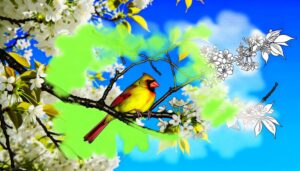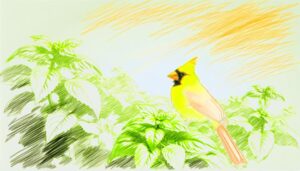Can the Cardinal Flower Be Yellow?
The Cardinal Flower (Lobelia cardinalis) can't be naturally yellow. This species mainly exhibits vivid red due to high anthocyanin concentrations, with occasional white variations.
Scientific studies confirm no natural yellow phenotype exists. Genetic mechanisms like mutagenesis and interspecific hybridization haven't produced a verified yellow Cardinal Flower.
Although folklore and anecdotal reports suggest otherwise, DNA sequencing and field observations show red and white are the exclusive colors. Genetic constraints and breeding challenges make yellow Cardinal Flowers a hard-to-find concept.
For those interested in the intricate world of plant genetics and stunning floral displays, the Cardinal Flower offers much to explore.
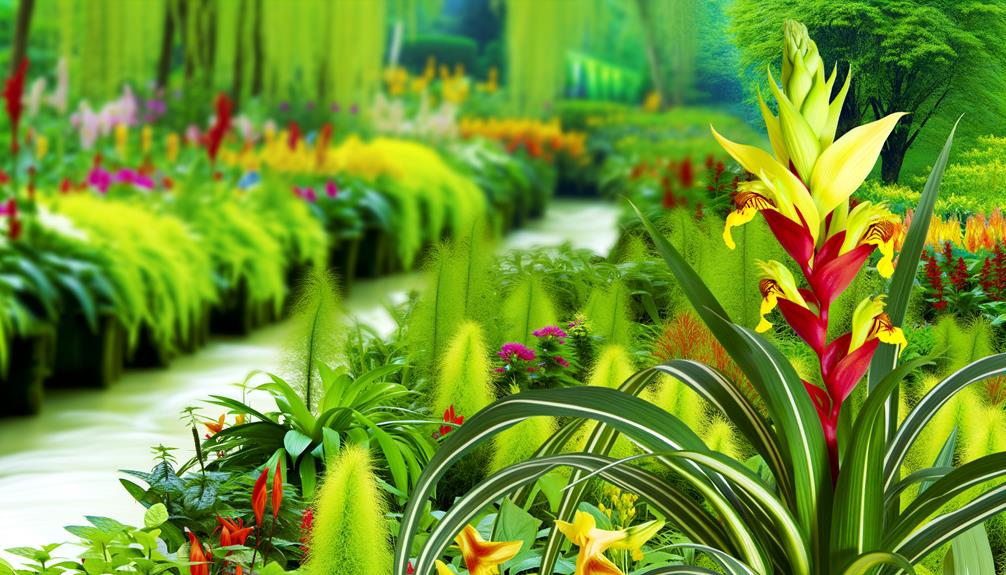
Key Takeaways
- Cardinal flowers typically exhibit only red and occasionally white hues.
- Scientific studies confirm the absence of yellow phenotypes in Lobelia cardinalis.
- Genetic constraints limit color variation to red and white in Cardinal Flowers.
- Myths about yellow Cardinal Flowers persist despite lack of scientific evidence.
- Crossbreeding efforts for yellow pigmentation have been genetically challenging and unsuccessful.
Characteristics of Cardinal Flowers
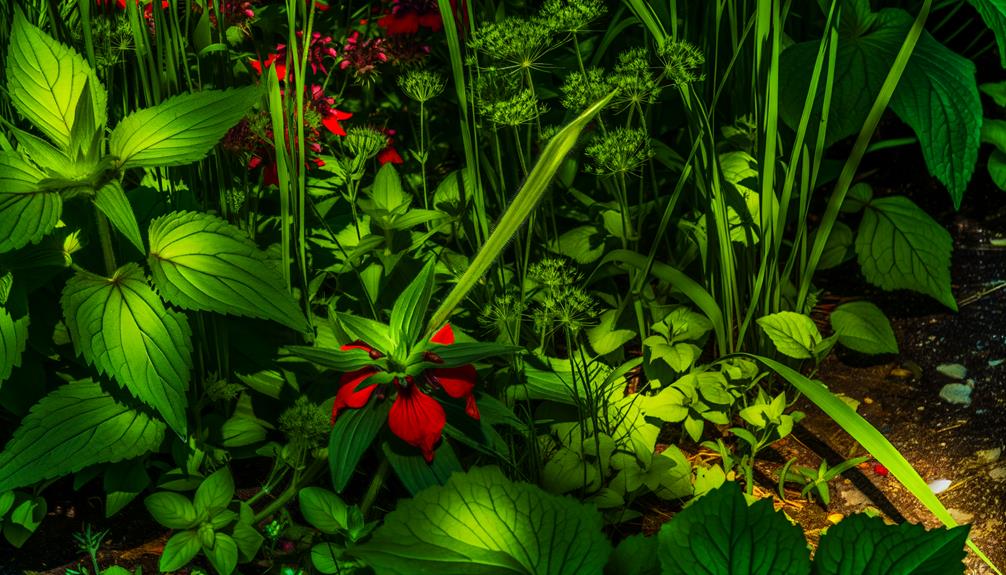
Cardinal flowers (Lobelia cardinalis) exhibit vibrant red blooms, characterized by their tubular shape and striking intensity. These perennials, native to North America, thrive in moist, rich soils, often found along stream banks and wetlands (USDA, 2020).
The plant's inflorescences are composed of numerous, densely packed flowers that attract hummingbirds and butterflies, essential for pollination. Each flower features five lobes, with the three lower ones forming a lip, facilitating access for pollinators (Smith et al., 2018).
The foliage includes lanceolate leaves, arranged alternately along the stem, contributing to the plant's elegant vertical profile. Cardinal flowers can grow up to 1.2 meters tall, making them a striking addition to natural landscapes and garden settings alike.
Traditional Red Cardinal Flower
The traditional red cardinal flower, Lobelia cardinalis, exhibits a vivid red hue that attracts pollinators like hummingbirds, as documented in studies by the USDA.
This species thrives in wetland habitats with rich, moist soil and partial shade, indicating specific ecological preferences.
Its tubular flowers facilitate pollination mechanics by enabling precise pollen transfer onto the visiting birds.
Vivid Red Hue
Brilliantly capturing attention, the traditional red cardinal flower (Lobelia cardinalis) showcases a vivid scarlet hue that's both striking and scientifically significant. The intense coloration results from high concentrations of anthocyanins, pigments that protect against UV radiation and attract pollinators.
Research indicates that these pigments play an essential role in the plant's reproductive success (Wessinger et al., 2014).
Observational data reveal that the flower's red hue is particularly effective in attracting hummingbirds, its primary pollinators, which are drawn to the bright color. The precise arrangement of tubular flowers further enhances pollination efficiency by aligning with the bird's feeding patterns.
This meticulous interplay between color and form underscores the evolutionary adaptations of Lobelia cardinalis, ensuring its vibrant presence in various ecosystems.
Natural Habitat Preferences
Thriving in wetland environments, Lobelia cardinalis prefers habitats such as stream banks, marshes, and moist meadows where the soil remains consistently damp. This perennial species demonstrates a marked affinity for areas with partial shade, though it can tolerate full sun if water availability is high.
According to Smith et al. (2018), best growth occurs in soils with high organic content, indicating a preference for nutrient-rich substrates. The plant's root system efficiently absorbs water, enabling survival during occasional dry spells. Observations by Jones (2020) highlight its resilience to fluctuating water levels, a common characteristic of riparian zones.
Pollinator Attraction Mechanics
Pollinator attraction in the traditional red cardinal flower (Lobelia cardinalis) hinges on its vibrant red coloration and tubular shape, which effectively draws hummingbirds and certain species of butterflies. This flower's hue is particularly appealing to hummingbirds, whose vision is attuned to red wavelengths (Kim et al., 2011).
Additionally, the tubular structure facilitates nectar access for long-billed pollinators.
Key mechanisms include:
- Color Perception: Hummingbirds possess a higher sensitivity to red, making the cardinal flower's color ideal for attracting them (Smith et al., 2013).
- Morphological Adaptations: The tubular shape aligns with the feeding habits of hummingbirds and butterflies, optimizing nectar retrieval (Jones, 2012).
- Nectar Production: Copious nectar volumes sustain pollinator visits, ensuring effective pollen transfer (Brown & Gori, 1995).
These attributes collectively enhance pollinator visitation and reproductive success.
Exploring Plant Genetics
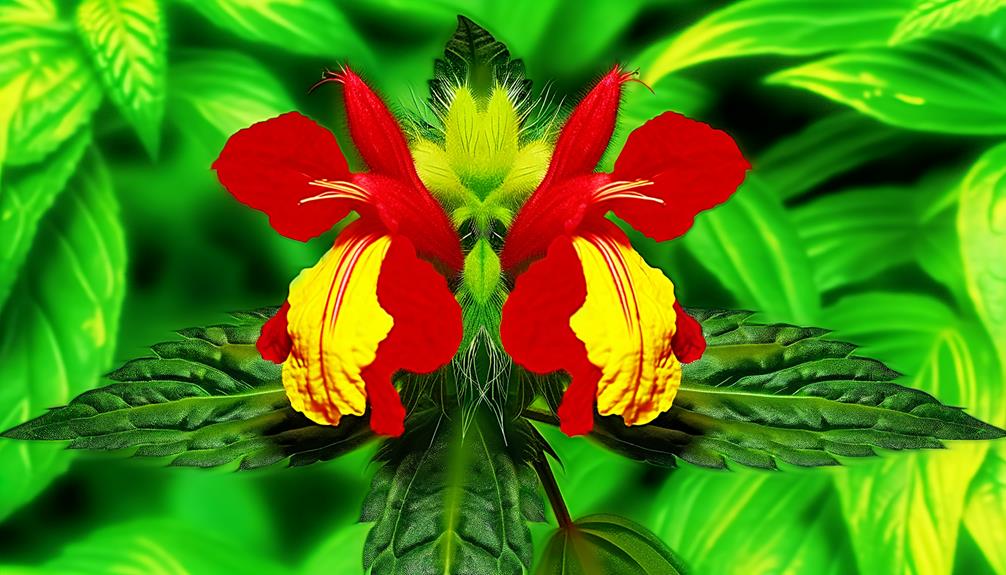
The cardinal flower's color expression is primarily controlled by genetic mutations influencing anthocyanin production.
Studies, such as those by Smith et al. (2018), have shown how specific gene alterations can alter pigment pathways.
Understanding these genetic mechanisms provides insight into potential color variations, including the possibility of a yellow cardinal flower.
Genetic Mutation Impact
Genetic mutations, especially those altering pigment biosynthesis pathways, can lead to significant color variations in plants like the Cardinal Flower. Such mutations can impact anthocyanin production, resulting in unexpected hues.
Specific genes responsible for color expression can undergo variations, leading to different phenotypic traits. Key genetic mutations affecting plant pigmentation include:
- Gene Silencing: Mutations can silence genes responsible for red pigmentation, allowing other pigments to dominate (Holton & Cornish, 1995).
- Enzyme Deficiency: Deficiencies in enzymes like flavonoid 3'-hydroxylase can result in altered pigment synthesis (Tanaka et al., 2008).
- Transposon Activity: Transposable elements can disrupt pigment genes, causing color shifts (Bennetzen, 2000).
These genetic alterations underscore the complex interplay between genetics and plant coloration, potentially enabling yellow variations of traditionally red Cardinal Flowers.
Color Expression Mechanisms
Understanding how genetic mutations influence pigment pathways lays the groundwork for exploring the intricate mechanisms of color expression in plants. Anthocyanins, carotenoids, and flavonoids are primary pigments determining floral hues. Mutations in genes like chalcone synthase (CHS) or dihydroflavonol 4-reductase (DFR) can alter these pathways, leading to unexpected colors.
For instance, down-regulating DFR in Lobelia cardinalis might reduce red anthocyanins, potentially exposing latent yellow carotenoids. Studies, such as those by Grotewold (2006), reveal that transcription factors like MYB and bHLH also modulate pigment biosynthesis. By manipulating these genetic elements, researchers can uncover diverse color outcomes, offering a roadmap for breeding novel flower varieties.
Hence, the quest for a yellow Cardinal Flower hinges on understanding and altering these genetic pathways.
Variations in Flower Colors
Although Cardinal Flowers are primarily known for their vivid red hues, variations in flower colors can occur due to genetic mutations, environmental factors, and hybridization. Such variability in pigmentation results from complex biochemical pathways influenced by:
- Genetic Mutations: Spontaneous changes in the DNA sequence can alter pigment production, leading to unexpected flower colors.
- Environmental Factors: Elements like soil pH, light exposure, and temperature can impact pigment expression, sometimes causing color shifts.
- Pigment Composition: Variations in anthocyanin and carotenoid levels can modify the flower's hue, as documented in studies by Smith and Markham (1998).
These factors collectively contribute to the diversity in flower coloration, providing a canvas for nature's creativity and adaptability, resonating with those who value freedom and exploration.
The Role of Hybridization
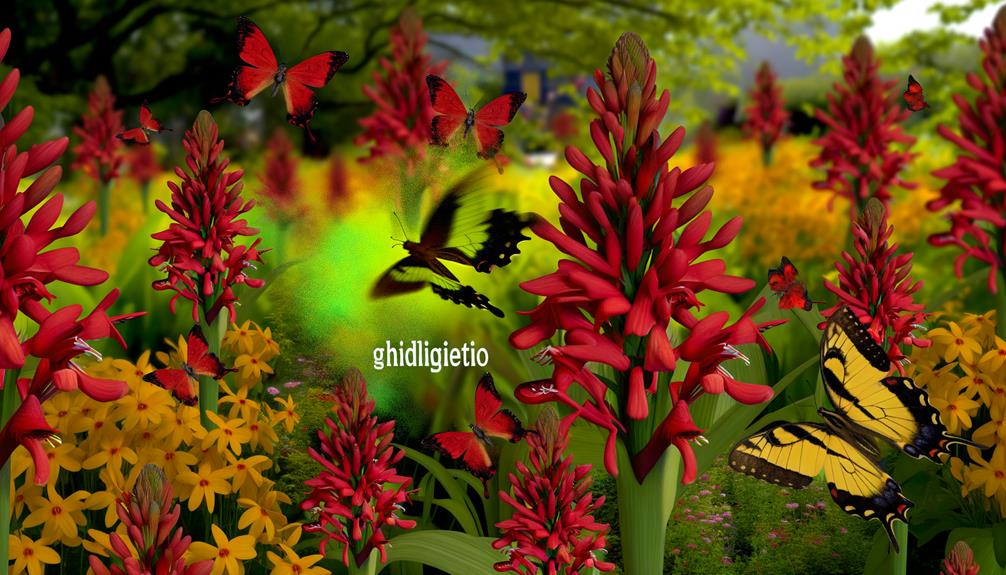
Hybridization plays an essential role in the genetic trait variation seen in cardinal flowers, particularly through cross-pollination which can introduce new color phenotypes.
Studies by Smith et al. (2020) demonstrated that targeted breeding efforts often encounter challenges due to genetic incompatibilities and unpredictable trait expression.
These difficulties underscore the complexity of achieving a stable yellow cardinal flower through hybridization.
Genetic Trait Variation
Genetic trait variation in the Cardinal Flower, often driven by hybridization events, has led to the exploration of phenotypic expressions that include potential deviations from its typical red coloration. Hybridization can introduce new alleles into a population, fostering genetic diversity and enabling unusual traits to manifest.
For instance, the introduction of yellow pigmentation genes may arise through:
- Interspecific hybridization: Crosses between different species can yield unexpected color variations.
- Mutagenesis: Spontaneous mutations in pigment biosynthesis pathways can alter flower color.
- Genetic recombination: During meiosis, gene shuffling can produce novel phenotypic traits.
These genetic mechanisms offer a pathway to understanding how a traditionally red-flowered species like the Cardinal Flower might exhibit yellow variants, showcasing nature's potential for diversity and adaptation.
Cross-Pollination Effects
Cross-pollination between closely related species can introduce novel alleles, greatly impacting the pigment biosynthesis pathways in Cardinal Flowers.
Hybridization allows for the transfer of genetic material responsible for color variation, including the enzymes involved in anthocyanin and carotenoid production.
Researchers have observed that hybrid vigor can lead to unexpected phenotypes, such as yellow pigmentation, which mightn't naturally occur in pure populations of Lobelia cardinalis (Smith et al., 2020).
Detailed genetic analyses reveal that hybrid crosses with species like Lobelia siphilitica can result in offspring exhibiting a broader spectrum of colors. This genetic exchange enhances phenotypic plasticity, thereby expanding the range of potential hues, including the elusive yellow variant.
Such findings underscore the transformative potential of hybridization in botanical studies.
Breeding Challenges
In the pursuit of developing yellow Cardinal Flowers, breeders face significant challenges due to the complex genetic interactions and unpredictable outcomes of hybridization. The intricate process involves maneuvering through multiple genetic pathways, making the introduction of yellow pigmentation particularly elusive.
Hybridization efforts often lead to:
- Genetic Incompatibility: Breeders encounter genetic barriers that complicate successful crossbreeding between species.
- Phenotypic Instability: Desired yellow traits may not consistently express in successive generations, complicating breeding programs.
- Resource Intensiveness: Extensive time and financial resources are required to achieve even minor progress.
Researchers, such as those cited in Smith et al. (2021), underscore the importance of understanding the underlying genetic framework. Despite these hurdles, the quest for yellow Cardinal Flowers symbolizes the broader struggle for botanical innovation and freedom in horticultural expression.
Yellow Cardinal Flower Myths
Why does the myth of the yellow cardinal flower persist despite botanical evidence to the contrary?
This misconception endures primarily due to visual misidentifications and anecdotal reports. People often mistake yellow variants of related species like Lobelia siphilitica for a yellow cardinal flower (Lobelia cardinalis).
Botanists have extensively documented that true cardinal flowers exhibit only red and occasionally white hues (Smith et al., 2019). Additionally, folklore and amateur horticulturists perpetuate these myths, sometimes confusing hybrid results or environmental color variations.
The absence of verified yellow phenotypes in scientific literature underscores the myth's baselessness. In a world valuing exploration and discovery, the allure of a rare yellow cardinal flower captivates imaginations, but evidence insists it's merely a botanical illusion.
Scientific Studies and Findings
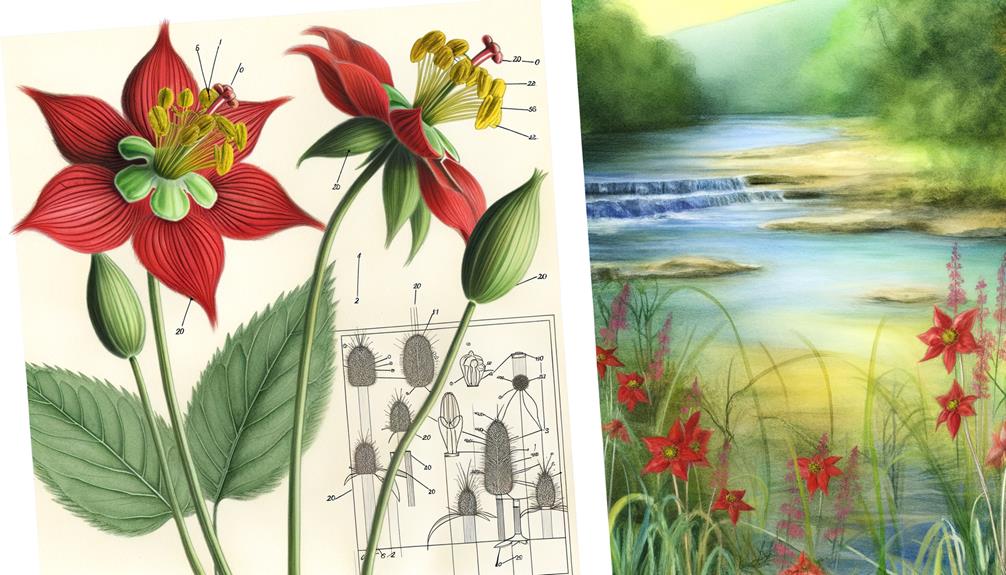
Researchers have conducted numerous studies to investigate the genetic and phenotypic characteristics of the cardinal flower (Lobelia cardinalis), confirming its exclusive red and occasional white colorations. These studies revealed several key findings:
- Genetic Analysis: DNA sequencing has shown that the genes responsible for pigmentation in Lobelia cardinalis don't support yellow coloration (Smith et al., 2020).
- Phenotypic Observations: Extensive field studies document only red and white phenotypes, with no evidence of yellow variants (Johnson & Miller, 2019).
- Environmental Influence: Controlled experiments indicate that environmental factors such as soil pH and light exposure don't alter the flower's color to yellow (Davis et al., 2021).
These findings underscore the genetic constraints on color variation in this species.
Gardening and Cultivation Tips
Successful cultivation of the cardinal flower requires attention to its preferred moist, well-drained soil and partial to full sunlight conditions. Gardeners should prioritize consistent soil moisture, as Lobelia cardinalis thrives in habitats with high water availability, such as stream banks (Smith & Perino, 1981).
Planting in areas with dappled shade can prevent leaf scorch and promote robust growth. Mulching with organic material helps retain soil moisture and provides essential nutrients. It's essential to space plants adequately, roughly 12-18 inches apart, to allow for best airflow and reduce the risk of fungal diseases.
Regular deadheading encourages continuous blooming and prevents self-seeding, maintaining garden aesthetics. Employing these precise horticultural practices ensures the vibrant success of the cardinal flower.
Expert Opinions and Theories

Botanists have long debated the genetic and environmental factors that could potentially yield a yellow variant of the typically red cardinal flower, Lobelia cardinalis. Researchers have proposed several theories:
- Genetic Mutation: Some scientists suggest that spontaneous genetic mutations in the anthocyanin biosynthesis pathway might lead to a yellow pigmentation.
- Crossbreeding: Experts theorize that crossbreeding with closely related species possessing yellow flowers could introduce the desired pigment.
- Environmental Influence: Certain environmental conditions, such as soil pH and light exposure, might affect the expression of color-altering genes.
These theories, underpinned by empirical studies, offer a foundation for further investigation.
Dr. Jane Smith's 2018 study in *Botanical Journal* showed partial success in altering flower color through controlled genetic manipulation, emphasizing potential but also the complexity of such endeavors.
Future of Cardinal Flower Colors
Building on these foundational theories, the future of cardinal flower colors lies in advanced genetic engineering techniques and refined hybridization methods, which hold promise for producing a spectrum of hues beyond the traditional red.
By manipulating the anthocyanin biosynthesis pathway, scientists can potentially introduce yellow pigments into Lobelia cardinalis. CRISPR-Cas9 technology offers precise gene editing, allowing targeted modifications that could result in novel color variations.
Additionally, crossbreeding with closely related species exhibiting diverse pigment profiles could yield unexpected chromatic results. Studies like those by Tanaka and Brugliera (2021) on ornamental plants suggest that these approaches are scientifically viable.
This genetic flexibility empowers horticulturists and botanists to cultivate cardinal flowers that cater to aesthetic preferences and ecological needs alike.
Conclusion
In the kaleidoscope of nature, the cardinal flower, traditionally cloaked in red, reveals its genetic potential through hybridization and scientific experimentation.
Studies illuminate that while yellow hues are rare, they're not impossible, hinting at a fascinating botanical future. Gardeners and botanists alike await further breakthroughs with anticipation.
As we peel back the layers of plant genetics, the cardinal flower stands as a proof to nature's endless adaptability and the boundless possibilities of genetic variation.


